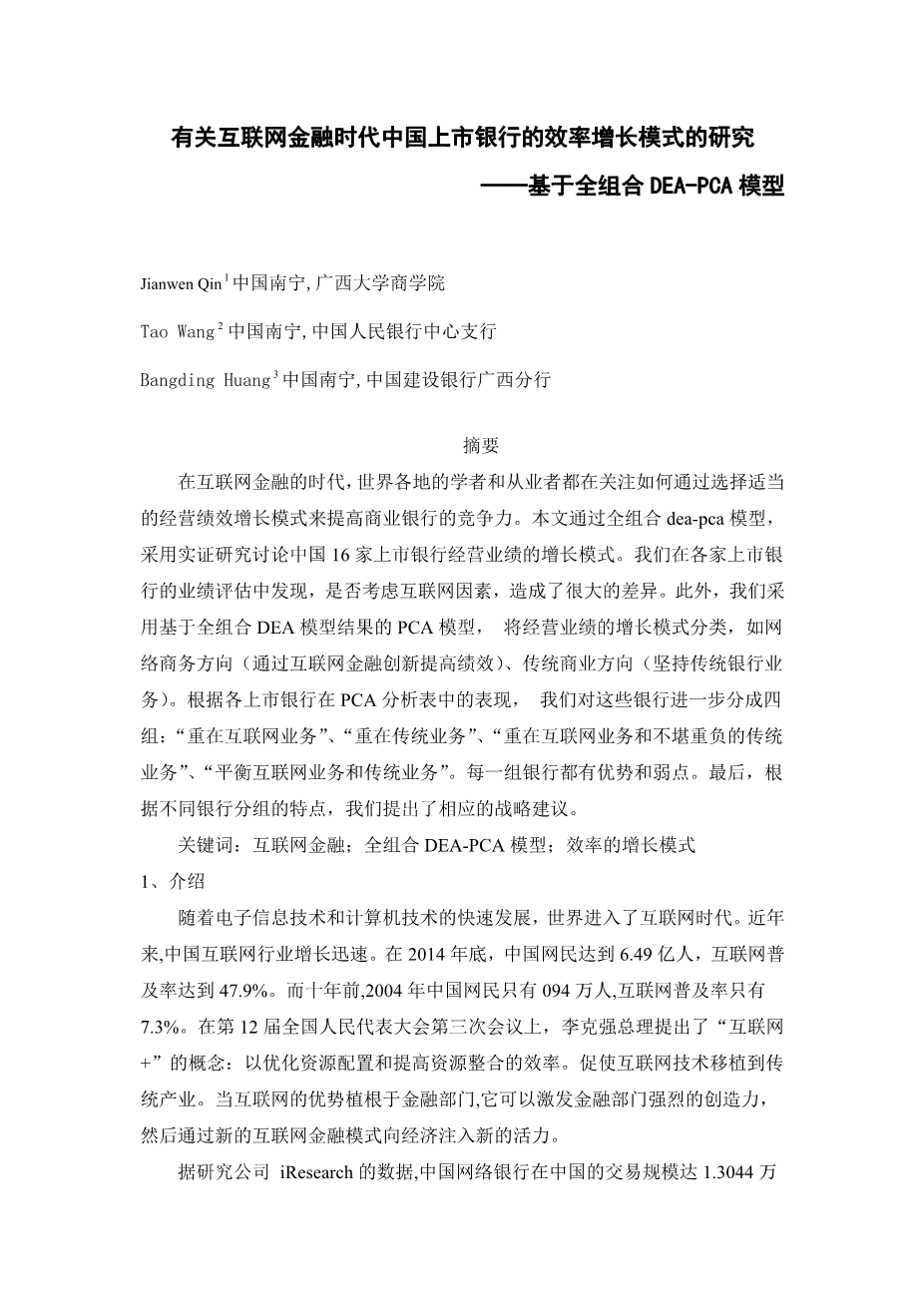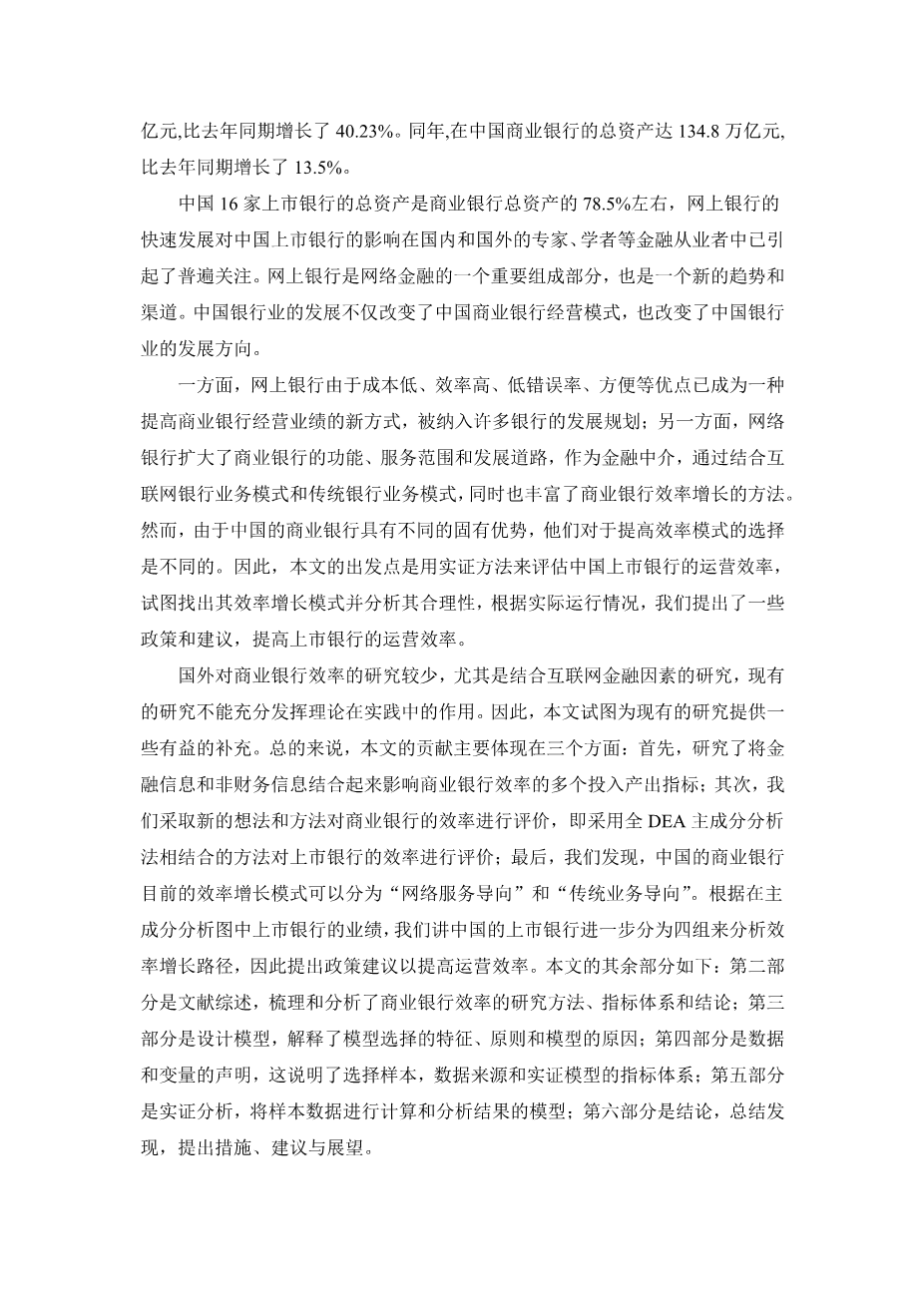The Study of Chinese Listed Bank’s Efficiency Growth Mode
in Internet Finance Era
—Based on Full-Combination DEA-PCA Model
Jianwen Qin1, Tao Wang1,2, Bangding Huang3
1Business School, Guangxi University, Nanning, China
2Nanning Central Branch, The People’s Bank of China, Nanning, China
3Nanning Yuanhu Subbranch, Guangxi Branch, China Construction Bank, Nanning, China
Abstract
In the era of internet finance, the scholars and practitioners around the world are pay-ing attention to how to enhance the competitiveness of commercial banks by choosing the appropriate growth pattern of business performance. This paper uses empirical research to discuss the growth model of business performance within 16 listed com-mercial banks in China by full-combination DEA-PCA model. We find that there are significant differences on the performance evaluation of each listed bank due to whether they consider internet factor or not. Furthermore, we apply PCA model which is based on the result of full-combination DEA model to classify the growth pattern of business performance into “Internet Business Oriented” which enhances performance by internet finance innovation and “Traditional Business Oriented” which maintains performance by traditional banking business. According to the performance of each listed bank in the PCA analysis chart, we classify these banks further into four groups: “Emphasis on internet business”, “Emphasis on traditional business”, “Emphasis on internet business with overburdened traditional business” and “Balance between internet business and traditional business”. Each group of banks has its own strength and weakness. At last, according to the characteristics of different bank groups, we put forward the corresponding efficiency strategy recommendations.
Keywords
Internet Finance, Full-Combination DEA-PCA Model, Efficiency Growth Model
1. Introduction
With the rapid development of electronic information technology and computer technology, the world entered the age of the Internet. In recent years, China’s internet in-dustry grows fast. As of the end of 2014, Chinese netizens reached 649 million people, the Internet penetration rate reached 47.9%; whereas a decade ago, in 2004 Chinese ne-tizens only had 0.94 million people, and the Internet penetration rate was only 7.3%1. At the third session of the 12th National People’s Congress, Premier Li proposed the concept of “Internet ” in order to optimize the allocation of resources and improve the efficiency of resources integration by prompting Internet technology graft into the tra-ditional industries. When the advantages of the Internet is rooted in the financial sec-tor, it can stimulate strong creativity in financial sector, and then format the new inter-net financial model to inject new vitality into economic.
According to the statistics of research firm iResearch, the deal size of China Internet banking in China has reached 1304.4 billion RMB, an increase of 40.23% compared to last year2. In the same year, the total assets of commercial banks in China amounted to 134.8 trillion RMB, an increase of 13.5% compared to last year3. The total asset of Chi-na’s 16 listed banks is about 78.5% of total commercial bank assets. The rapid develop-ment of Internet banking that affects Chinese listed banks has caused widespread con-cern in financial practitioners, experts and scholars at domestic and abroad. Internet banking as an important part of Internet finance, as well as a new trend and channel of China’s banking industry development not only changes the Chinese commercial bank business model, but also changes the development direction of China’s banking industry.
On the one hand, internet banking due to the low cost, high efficiency, low error rate, convenience and other advantages has become a new way to improve the operating performance of Chinese commercial banks and has been incorporated into many banks’ development planning; On the other hand, internet banking has expanded the commercial bank’s function, scope of services and development path as a financial in-termediary by combining the Internet banking business mode and traditional banking business mode, and also enriched the commercial banks’ ways of efficiency growth at the same time. However, due to the different inherent advantages of Chinese commer-cial banks, their choices of enhancing efficiency patterns are different. Therefore, the starting point of this paper is using empirical means to evaluate the operating efficiency of China’s listed banks, trying to find out its current efficiency growth pattern and ana-lyze the reasonableness of its efficiency growth pattern, and according to the actual op-eration situation, we put forward some policies and recommendations to improve the operating efficiency of sample listed banks.
With respect to foreign countries, the studies of commercial banks’ efficiency are less, especially those combined with Internet banking factors, the existing research cannot give full play to the role of theory into practice. Therefore, this article attempts to provide some useful supplement for existing studies. In general, contribution of this paper is mainly reflected in three aspects: Firstly, we study multiple input and output indicators which are impacting commercial bank’s efficiency by incorporating the fi-nancial information and non-financial information; Secondly, we take new ideas and methods to evaluate the efficiency of commercial banks, namely: the use of a combina-tion of full-DEA-PCA model to evaluate the efficiency of the listed banks; Finally, we found that the current efficiency growth pattern of China’s commercial banks can be divided into “network service oriented” and “tradition
剩余内容已隐藏,支付完成后下载完整资料


英语译文共 10 页,剩余内容已隐藏,支付完成后下载完整资料
资料编号:[484127],资料为PDF文档或Word文档,PDF文档可免费转换为Word


